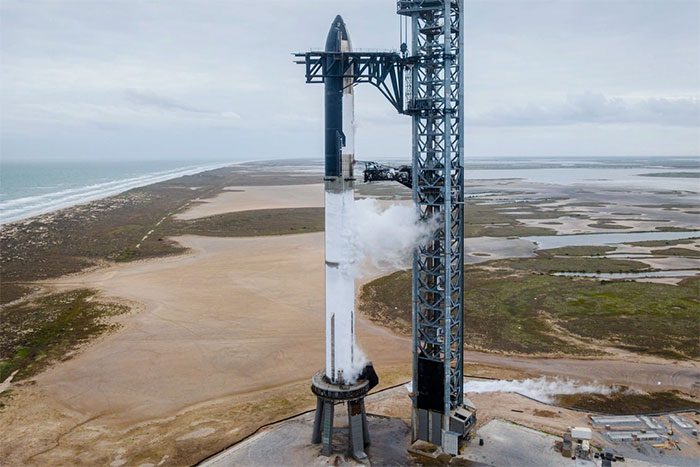At 1 PM GMT on November 18 (8 PM Vietnam time), a gigantic 120-meter rocket launched from the launch pad in Boca Chica, USA. However, both stages of the rocket exploded.
Why This Test Is Considered a Success for SpaceX
As planned, seven minutes after launch, the rocket was supposed to perform stage separation, after which the Super Heavy booster would land back in the Gulf of Mexico.
Meanwhile, the upper section of the Starship was to proceed to orbit, perform a partial orbit around our planet, and return to the Hawaiian Islands after 90 minutes from the launch time.
However, during yesterday’s test, both stages of the rocket exploded.
The world’s most powerful rocket successfully launched. (Source: Space).
Specifically, after the Starship successfully separated, considered the riskiest phase of this test, the Super Heavy booster flipped back to Earth.
Six engines on the Super Heavy ignited successfully, serving during the landing back to Earth, but it exploded in the sky.
Meanwhile, the upper section of the rocket, the Starship spacecraft, also activated its engines and continued to fly to an altitude of 148 km, surpassing the Kármán Line, the official boundary between Earth’s atmosphere and space. However, ground control lost signal with the spacecraft, leading to an explosion.
Currently, it is unclear whether these two explosions were due to the engineering team sending a self-destruct command.
However, experts evaluate this as a successful test for SpaceX as the rocket overcame failures from the first test that took place on April 20.
The Starship rocket launched from the pad with all 33 Raptor engines equipped on the Super Heavy booster operational. Meanwhile, the phase that SpaceX was most concerned about in this test, the separation of the Starship, was also successful.
After the Starship test, the head of SpaceX congratulated the SpaceX team on social media platform X (formerly Twitter) for their achievements.
The second test flight is described as very promising for SpaceX and provides a glimpse into a potentially even more successful third flight, expected as early as January 2024.
How Will Starship Impact Future Missions?
The development of Starship seems not fast enough to align with the plans of NASA, which has contracted with SpaceX to use Starship as a lunar lander to bring astronauts to the surface of the Moon for the first time since 1972.

Starship rocket at the space launch site in Boca Chica, USA. (Photo: Space).
This mission is named Artemis 3, officially planned for 2025, a timeline that increasingly seems unrealistic if the Starship cannot achieve completely successful tests.
Elon Musk aims to turn Starship into a popular means of transportation to any destination in the Solar System, including Mars. Its goal is to establish a self-sustaining colony on the Red Planet, making humanity a multiplanetary species.
The head of SpaceX explained that if the size of Starship is considered too large for a rocket, it is because building a long-term base on the Moon and a city on Mars requires a vehicle capable of carrying millions of tons of payload.
But the innovation of Starship is that it is fully reusable, with two stages designed to return to the launch pad, thus reducing transportation costs.
Currently, only the first stage of SpaceX’s Falcon 9 rocket is reusable.
Starship is larger than NASA’s SLS rocket, which first launched a year ago, and the legendary Saturn V rocket, which was used for the Apollo Moon program (111m long). The thrust at launch of Starship is also twice as strong as these two launch vehicles.


















































